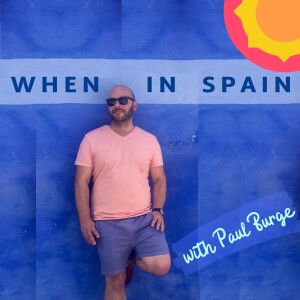
Semana Santa: Easter in Spain, processions, passion & pointy hats
 2019-04-25
2019-04-25
Download
Right click and do "save link as"
Semana Santa or Holy Week is the biggest religious celebration of the year in Spain.
What's the story behind those 'pointy hats' (capirotes)? What the difference is between a 'Trono' and a "Paso' float? And how did this Spanish religious tradition all start?
To find out more, Karina and I head down to Málaga to watch the religious processions that include elaborate floats bearing scenes from the Passion of Christ. Although, usually solemn – this is still Spain, which means neither the strong religious beliefs nor the sombreness of the moment can hide the nation’s fervour for lively fiestas - especially in Andalucía!
Join us in the streets of Málaga as we watch two processions from two different 'cofradías' or brotherhoods, one called 'Piety' and the other 'Sepulchre' on Good Friday. As the beat of the marching drummers approach and the smell of sweet incense fills the evening air, I'll describe the sights, sounds and atmosphere of Easter in Spain. In this episode we also catch up with two Spanish friends, Jose and Félix who give us their take on the history and traditions of Semana Santa in Andalucía.
One of the most distinctive features of Málaga's Semana Santa is the presence of huge ornate floats, carried through the streets by hundreds of 'brotherhood' members. These thrones depicting scenes from the Passion are escorted by groups of penitents wearing long purple robes and women in black holding lit candles. The silence is occasionally broken by spontaneous 'saetas' typical Spanish religious music with Arabic influences, usually performed from a balcony during a procession.
view more
More Episodes
Gran Vía — Madrid’s most iconic street
 2024-02-16
2024-02-16
 2024-02-16
2024-02-16
A postcard from El Puerto de Santa María
 2023-09-13
2023-09-13
 2023-09-13
2023-09-13
Where to visit in Spain with Karen Rosenblum
 2022-04-29
2022-04-29
 2022-04-29
2022-04-29
A day trip to Cuenca and its hanging houses
 2022-04-18
2022-04-18
 2022-04-18
2022-04-18
Ten must-visit Madrid bars with Chris Lynch
 2022-04-11
2022-04-11
 2022-04-11
2022-04-11
Cycling Southern Spain with Chris Atkin
 2021-09-01
2021-09-01
 2021-09-01
2021-09-01
012345678910111213141516171819
Create your
podcast in
minutes
- Full-featured podcast site
- Unlimited storage and bandwidth
- Comprehensive podcast stats
- Distribute to Apple Podcasts, Spotify, and more
- Make money with your podcast
It is Free
- Privacy Policy
- Cookie Policy
- Terms of Use
- Consent Preferences
- Copyright © 2015-2024 Podbean.com




